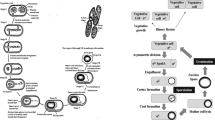Abstract
The D95°C value of Bacillus thuringiensis spores plated in the presence of lysozyme increased from 3.0 min to 3.6 min by post-treatment of heat-injured spores with 50mm EDTA. In the case of Bacillus alvei and Bacillus polymyxa spores D-values decreased from 4.9 to 4.3 min and from 4.7 to 4.1 min respectively. Post-treatment of heat-injured spores treated with alkaline thioglycollate increased D95°C values of Bacillus alvei from 4.2 to 5.3 min, B. thuringiensis 3.6 to 4.7 min, and Bacillus polymyxa from 4.2 to 5.0 min when spores were plated in the presence of lysozyme. Electron micrographs of heat-injured B. alvei spores treated with sodium thioglycollate indicated that the coat layers of the treated spores were granulated and less intact than the control spores.
Similar content being viewed by others
References
Adams, D. 1974 Requirements for and sensitivity to lysozyme by Clostridium perfringens spores heated at ultrahigh temperatures. Applied Microbiology 27, 797–801.
Aronson, A., & Fitz James, P. 1976 Structure and morphogensis of bacterial spore coat. Bacteriological Reviews 50, 360–402.
Baker, J. & Griffiths, M. 1983 Predictive modelling of psychrotropic Bacillus cereus. Journal of Food Protection 56, 684–688.
Dingman, D. & Stahly, D. 1983 Media promoting sporulation of Bacillus larvae and metabolism of medium components. Applied and Environmental Microbiology 46, 860–869.
Duncan, C., Labbe, R. & Reich, R. 1972 Germination of heat and alkali altered spores of Clostridium perfringens type A by lysozyme and an initiation protein. Journal of Bacteriology 109, 550–559.
Favret, M., & Yousten, A. 1985 Insecticidal activity of Bacillus laterosporus. Journal of Invertebrate Pathology 45, 195–203.
Franceschini, T. & Labbe, R. 1979 Sensitivity of chemically treated spores of Clostridium perfringens type A to an initiation protein. Microbios 25, 85–91.
Gordon, R., Haynes, W. & Pang, C. 1973 The genus Bacillus. USDA Agricultural Handbook 427.
Gould, G.W. & King, W.L. 1969 Action and properties of spore germination enzymes. In Spores IV, ed. Campbell, L. pp. 276–288. Washington, DC: American Society for Microbiology.
Hughey, V. & Johnson, E. 1987 Antimicrobial activity of lysozyme against bacteria involved in food spoilage and food-borne disease. Applied and Environmental Microbiology 53, 2165–2170.
Kutima, P. & Foegeding, P. 1987 Involvement of spore coat in germination of Bacillus cereus T spores. Applied and Environmental Microbiology 53, 47–52.
Labbe, R. Rufner, R. 1980 Ultrastructure of sporulating cells of Clostridium perfringens type A grown in the presence of raffinose. Canadian Journal of Microbiology 26, 1153–1157.
Lund, B. & Peck, M., 1994 Heat resistance and recovery of spores of non-proteolytic Clostridium botulinum in relation to refrigerated, processed foods with an extended shelf life. Journal of Applied Bacteriology, Symposium Supplement 76, 115S-128S.
Peck, M.W. & Fernandez, P.S. 1995 Effect of lysozyme concentration, heating at 90°C, and then incubation at chilled temperatures on growth from spores of non-proteolytic Clostridium botulinum. Letters in Applied Microbiology 21, 50–54.
Peck, M., Fairbairn, D. & Lund, B. 1992 Factors affecting growth from heat treated spores of non-proteolytic Clostridium botulinum. Letters in Applied Microbiology 15, 152–155.
Stumbo, C. 1965. Thermobacteriology in food processing. New York: Academic Press.
Tang, S. & Labbe, R. 1987. Mode of action of Clostridium perfringens initiation protein (spore-lytic enzyme). Annales de l'Institut Pasteur/Microbiology 138, 597–608.
Author information
Authors and Affiliations
Rights and permissions
About this article
Cite this article
Rasmussen, T.M., Labbé, R.G. Recoverability of heat-injured Bacillus spores by lysozyme and EDTA or alkaline thioglycollate. World Journal of Microbiology & Biotechnology 12, 595–599 (1996). https://doi.org/10.1007/BF00327721
Revised:
Accepted:
Issue Date:
DOI: https://doi.org/10.1007/BF00327721




